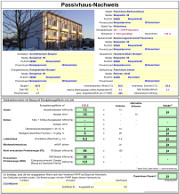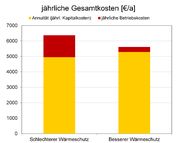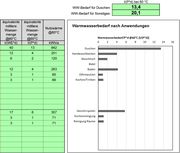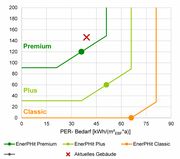designPH and PHPP
designPH have to be used in conjunction with PHPP to design a Passive House and make a full analysis.
 +
+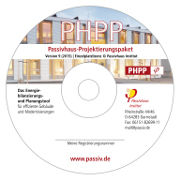 =
= 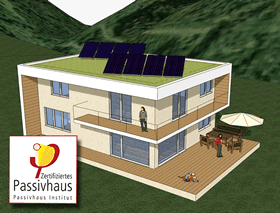
designPH versions are compatible with PHPP 8.5 and/or PHPP 9 depending on license and version you have purchased. For a detailed view look here.
The PPP export file created by designPH can be imported into PHPP 8 and/or PHPP 9 depending on your purchased version of designPH to add further detail and perform verification.
To be able to import designPH export files into PHPP 8 or PHPP 9, you need a corresponding spreadsheet software.
You can get detailed information on that in your current PHPP handbook. Please also have a close look for your system requirements here.
Passive House Planning Package (PHPP)
The energy balance and planning tool for efficient buildings and refurbishments
|
|
The PHPP is an easy to use planning tool for energy efficiency for the use of architects and planning experts. The reliability of the calculation results and ease of use of this planning tool has already been experienced by several thousand users.
|
Planning Passive House buildings and NZEBs – made easy with the PHPP
The tried and tested Passive House Planning Package provides reliable results for the following:
|
|
The advantages of the Passive House Planning Package
|
|
|
System requirements for use of the workbook
The PHPP is based on an MS Excel workbook in the xlsx/xlsm format. Microsoft Windows XP (or higher) and Microsoft Excel 2007 (or higher) are system requirements. As far as the authors are aware, the PHPP can also be used with current versions of OpenOffice or LibreOffice, on Linux systems, and on Macintosh computers. However, depending on the platforms used and their programming, there may be limited functionality of the calculation tool or the macros of the additional tool.
Available now: PHPP 9 – Latest version with many new applications
|
|
|
Verification in accordance with the international EnerPHit criteria for modernisation of buildings |
|
|
The international EnerPHit criteria make it possible to specify minimum quality standards for the relevant building components in a refurbishment project depending on the location. In addition, the requirements with reference to the cooling and dehumidification demands can be determined depending on the use-related internal loads and the climate prevailing at the location. |
|
Management of different design variants or refurbishment steps |
|
|
The PHPP 9 enables input of efficiency parameters for different variants into a single PHPP file. The results for the variants are entered sorted in columns and are calculated in parallel so that the effects of these parameters can be compared easily. |
|
|
In this way, different steps of a refurbishment can also be input into a single PHPP file. This makes it possible to depict the improvement in efficiency resulting from each individual refurbishment step and to enter and assess projects with a long-term strategy in a convenient manner. |
|
|
|
|
Economic feasibility comparisons of different variants can be carried out in a separate worksheet. Besides information about the financial boundary conditions, it is also possible to specify whether the economic feasibility comparison should be performed for the entire building or only relating to individual components. |
|
Data input assistance by means of error messages, warnings and plausibility checks |
|
The message function for incorrect or missing data input has been systematically reviewed. All messages have now been compiled in a new worksheet prepared for this purpose. In this way users can receive clear information regarding the places where incorrect, or incomplete or implausible data has been entered and needs rechecking or reviewing. |
|
|
|
|
The input options for calculation of distribution losses of heating or hot water pipes have been extended considerably. Besides the possibility of entering several pipe systems, it is now also possible to take into account heat recovery systems for shower water. The hot water demand can alternatively be assessed in detail in order to ascertain further potentials for saving energy for example based on the use of flow-optimised fittings. |
|
Implementation of evaluation method according to the PER factor classification system |
|
|
During the course of their service life, buildings being planned today will be supplied with renewable energy to an increasing extent. This fact has already been taken into account in the PHPP 9: as an alternative to the evaluation method used previously, which was based on the non-renewable primary energy factors (PE factors), buildings can now be assessed according to the new system for renewable primary energy (PER / Primary Energy Renewable). |
|
Certification according to the Passive House categories Classic, Plus and Premium |
|
|
The new Passive House categories (Classic, Plus, Premium) allow evaluation of building efficiency taking into account the interplay of energy efficiency and renewable energy generation. As an alternative, classical verification of the Passive House Standard will continue to be offered for buildings with a heating demand of 15 kWh/(m²a) and a primary energy demand of 120 kWh/(m²a), without any renewable energy generators additionally – this corresponds with the category Passive House Classic according to the new PER factor method.. |
Passive House Planning Package – a tried and tested planning tool
The PHPP based on Excel was introduced for the first time in 1998 and has been continually further developed ever since. Calculation sheets for space heating balances (annual and monthly methods), and for heat distribution and supply as well as for the electricity and primary energy demand, constitute the main features of this tool. Essential modules were successively supplemented for the practical planning of energy efficiency projects throughout the world, including the calculation of characteristic values of windows, shading, heating load and summer behaviour, cooling and dehumidification demand, ventilation for large objects and non-residential buildings, taking into account of renewable energy sources, and EnerPHit certification (retrofitting of existing buildings). The PHPP is continually being validated and extended on the basis of measured values and new research findings.
In the context of accompanying scientific research in several objects, measured results were compared with the calculated results. In the process, a high correlation could be demonstrated between the demand calculated using the PHPP and the consumption ascertained through scientific monitoring projects. With careful planning of building efficiency, there will be no performance gaps.


